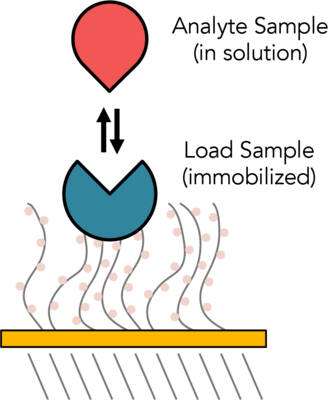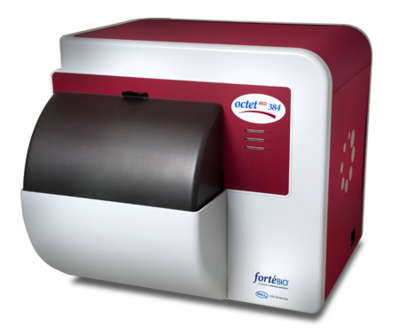Biolayer Interferometry (BLI)
BLI at the CMI
Bio-Layer Interferometry (BLI) is an optical technique for measuring macromolecular interactions by analyzing interference patterns of white light reflected from the surface of a biosensor tip. BLI experiments are used to determine the kinetics and affinity of molecular interactions. In a BLI experiment, one molecule is immobilized to a Dip and Read Biosensor and binding to a second molecule is measured. A change in the number of molecules bound to the end of the biosensor tip causes a shift in the interference pattern that is measured in real-time.



The CMI has two Sartorius (formerly ForteBio) instruments for measuring BLI: the Octet RED384 (now called Octet RH16) and the BLItz (now called Octet N1). The Octet RED384 is more sensitive and higher throughput and can be used for macromolecular and small molecule binding experiments. The BLItz uses a very small sample volume, but is more time consuming and cannot measure molecules smaller than 10 KDa.
Applications and Features
Applications
- Kinetic binding: ka, kd
- Equilibrium binding: KD
- Macromolecular and small molecule binding (Octet only)
Octet RED384 Key Features
- Simultaneous real-time binding on up to 16 biosensors
- Disposable biosensors (sensor regeneration not required)
- 96 or 384 well reagent plate format
- Small molecule sensitivity
BLItz Key Features
- Low sample volume: 4 μl sample
- Disposable biosensors (sensor regeneration not required)
Theory and Design
In a BLI experiment, one molecule is immobilized to a Dip and Read Biosensor and binding to a second molecule is measured. A change in the number of molecules bound to the end of the biosensor tip causes a shift in the interference pattern that is measured in real-time. Sensors are moved from one well of a microplate to another to change solution from samples (load sample and analyte sample) to buffer for baselines and dissocation.

Figure adapted from ForteBio.
BLI Experimental Phases
There are two major phases in a BLI experiment and each will need to be optimized for you experiment. Regeneration is an optional third phase that may be used when a single set of sensors is reused for multiple measurements.
Immobilization
- the Load molecule is attached irreversibly or reversibly to the sensor chip surface
Interaction analysis
- In the association phase, the Analyte is injected over the sensor surface
- In the dissociation phase, the Analyte is washed off the surface
Regeneration
- the surface is regenerated by removing remaining bound analyte or by removing ligand (which will also remove remaining analyte)

Data Files - About CMI Data Files
Users are responsible for storage of all raw and processed data collected at the CMI.
- Users should have a plan to copy or transfer all raw and process data to their own local or cloud storage system.
- While the CMI allows temporary local storage of CMI User data on the instrument computer, we make no guarantees on the security or long-term availability of any data at the CMI.
- For most (but not all) CMI technologies, the raw data files and recommended readable exports are relatively small and can be readily transferred electronically.
- See specific instruments for exceptions and for details about the software, data file types and recommended data exports.
Data Sharing:
- Currently, a Generalist Repository is the recommended data repository for most CMI data types, as stable specialist data repositories have not been established.
Data Files - BLI - Octet RH16 (RED384)
| Technology | Biolayer Interferometry | ||
| Instrument | Octet RH16 (Octet Red 384) | ||
| Recommended Repository | Generalist Repository | ||
| Software Type | Data Collection | ||
| Current Version | Octet BLI Discovery, Version 13.0 | ||
| Data Files (Type, ~size) | experiment folder (contents below) | 5 MB/experiment | |
| data file | .frd | 80 KB/measurement | |
| method file | .fmf | 35-45 KB/experiment | |
| plate definitions | .jpg | 30-90 KB/plate | |
| assay image | .jpg | 30-90 KB/experiment | |
| preprocessed data | .xslx | 200 KB/experiment | |
| Software Type | Data Analysis | ||
| Current Version | Octet Analysis Studio, Version 13.0 | ||
| Data Files (Type, ~size) | HT Settings | ||
| Readable Exports | results table | .xslx | 5-10 KB |
| Export Report | .xslx | ||
Data Files - BLI - BLItz
| Technology | Biolayer Interferometry | ||
| Instrument | Blitz | ||
| Recommended Repository | Generalist Repository | ||
| Software Type | Data Collection & Analysis | ||
| Current Version | Blitz Pro 1, Version 1.2.1.5 | ||
| Data Files (Type, ~size) | experiment file | .dataset | |
| Readable Exports | data file | .csv | 20-150 KB/measurement |
| image file | .jpeg | 40-100 KB/image | |
CMI OctetRED384 BLI Getting Started Guide
CMI OctetRED384 Guide to Epitope Binning
Bio-Layer Interferometry (BLI) Technology from Sartorius (formerly ForteBio)
Purchase BLI Dip and Read sensors from Sartorius (formerly ForteBio)
CMI BLItz Getting Started Guide
BLItz User Guide from ForteBio
Bio-Layer Interferometry (BLI) Technology page from ForteBio
BLItz Product Information from ForteBio
Purchase BLI Dip and Read sensors from ForteBio
Octet RED 384 Supplies
User-Provided Required supplies:
- Sartorius (formerly ForteBio) Dip and Read sensors
- Black 96-well plate to soak sensors
- Black 96-well or 384-well plate for samples and reagents
- Pipettors for sample handling
Optional provided supplies and equipement:
- Empty BLI Sensor trays to use as working tray during experiment
- 8-sensor transfer tool
- Refrigerated centrifuge with microplate rotor
BLItz Supplies
User-Provide Required supplies:
- Sartorius (formerly ForteBio) Dip and Read sensors
- 96-well plate to soak sensors
CMI-Provide Required Supplies:
- Black 0.5 ml tubes (provided by CMI)
| Popular Dip and Read Biosensors for Kinetics* | Part Number |
| Streptavidin (SA) biosensors | 18-5019 (96/tray) |
| High Precision Streptavidin (SAX) biosensors | 18-5117 |
| Super-Streptavidin (SSA) biosensors (for small molecules) | 18-5057 |
| anti-His (HIS1K) biosensors | 18-5120 |
| Ni-NTA (NTA) biosensors | 18-5101 |
| Anti-Human IgG Fc biosensors | 18-5010 |
* See Sartorius (formerly ForteBio) BLI website for more sensor types
| OCTET Black Microplates** | Part Number |
| Greiner Bio-One 96-well black flat-bottom PP, 200 µL | 655209 (VWR 82050-784) |
| Greiner Bio-One 384-well black flat-bottom PP, 80-120 µL | 781209 (VWR 82051-318) |
| ForteBio 384-well black tilted-bottom PP, 60 µL | 18-5080 |
** Only Greiner Bio-One brand, black microplates or Sartorius (formerly ForteBio) plates are recommended by Sartorius for the Octet sample and reagent plate.
